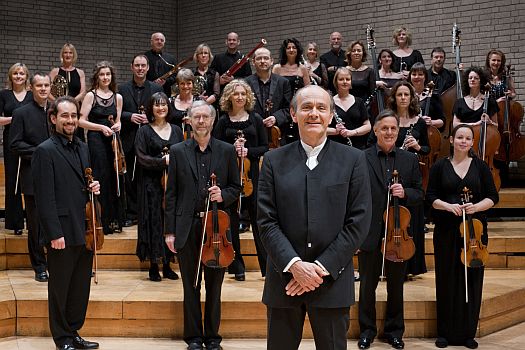 United Kingdom Bartók, Kodály and Haydn: Dame Evelyn Glennie (percussion), Janet Fulton (percussion), Noriko Ogawa (piano), Philip Smith (piano), Manchester Camerata/Gábor Takács-Nagy, Bridgwater Hall, Manchester, 28.1. 2012 (MC)
United Kingdom Bartók, Kodály and Haydn: Dame Evelyn Glennie (percussion), Janet Fulton (percussion), Noriko Ogawa (piano), Philip Smith (piano), Manchester Camerata/Gábor Takács-Nagy, Bridgwater Hall, Manchester, 28.1. 2012 (MC)
Portrait of a Hungarian: Part 2
Bartók – Concerto for two pianos, percussion and orchestra (1937, orch. 1940)
Kodály – Dances of Galánta (1933)
Haydn – Symphony No.104 in D major ‘London’(1795)

At the Bridgewater Hall the Manchester Camerata programme titled ‘Portrait of a Hungarian ’was the second in their series of music connected to the homeland of Gábor Takács-Nagy in his inaugural season as music director. Any lingering resentment at not having at least one Frederick Delius work on this the weekend of the 150th anniversary of Delius’ birth soon got blown away with this stunningly played and fascinating Hungarian themed programme.
The opening work of the evening was Bartók’s rarely heard Concerto for two pianos, percussion and orchestra completed in 1940, an arrangement of his earlier Sonata for two pianos and percussion from 1937. In three contrasting movements Bartók emphasises the percussive nature of the two pianos resolutely performed by Noriko Ogawa and Philip Smith together with a battery of percussion instruments including timpani; side drums; xylophone and tam-tam expertly played by Dame Evelyn Glennie and Janet Fulton. The spiky and brutal rhythms of the sinister opening movement Assai lento seemed to reflect the anguish and tension that would have been circulating around pre-war Europe. I loved the mesmerizing slow movement, a highly chromatic yet serene elegy. Complex and densely textured the Finale was especially well performed by the Camerata creating a broad range of vibrant colours.
Kodály created the Dances of Galánta in 1933 from five gypsy melodies that he had heard in the then Hungarian market town of Gálanta. In Munich last May I heard the Munich Philharmonic under Lionel Bringuier play the Dances of Galánta so splendidly but this exceptional performance from the Camerata was in a different league. Vividly coloured the writing of gripping rhythmic intensity provided the Camerata with a marvellous platform to display their talents with the woodwind covering themselves in glory especially the entrancingly played solo clarinet. Sounding as glorious as I have heard from any orchestra in this hall the Camerata strings are a match to be reckoned with.
Although he was an Austrian by birth I’m glad that music from Haydn was included in this Hungarian themed programme concert. I guess Haydn qualified, as for most of his adult life he lived and worked for the Esterházy Court in what was then part of Hungary. Known as the ‘London’or ‘Salomon Symphony’ – the last symphony that Haydn wrote – written and composed in England in 1795, the Symphony No.104 in D major is one of his finest works. For this symphony the Camerata were asked to play standing up. Takács-Nagy’s commanding reading was remarkable in its splendour and broad expression an absorbing mix of memorable lyricism and buoyant rhythms. Vitality and sheer joyousness of the opening movement filled the hall followed by an Andante of Viennese grace if sounding rather sombre. Containing cheerfully infectious music of unusual accents and abrupt melodrama the Menuet was quite sparklingly played. I’m always struck how the excitable flourish at the end of the main theme sounds so remarkably like Ron Goodwin’s ‘Miss Jane Marple theme’ to the Margaret Rutherford series of films. The Finale clearly designed by Haydn with audience appeal in mind did just that with the Camerata in remarkable form galloping along with effervescence providing considerable thrust and forward momentum. For his encore Takács-Nagy repeated the movement.
This was a quite stunning concert by the Manchester Camerata which confirms to me that in Gábor Takács-Nagy they have found their ideal music director.
Michael Cookson